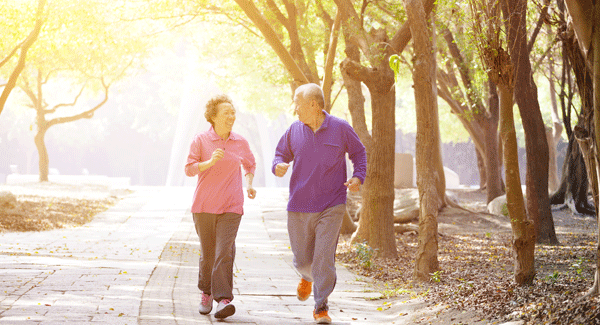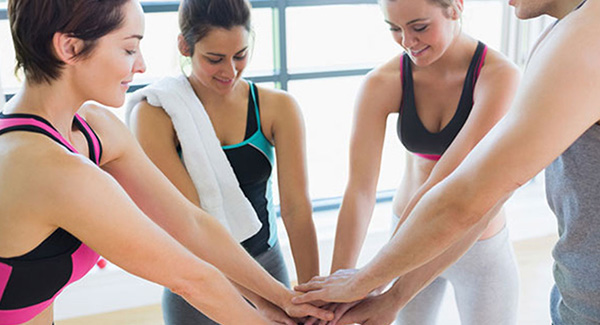How to Start an Exercise Program
Get the tools you need to safely start a workout routine and don’t let arthritis stop you from reaping the rewards of lifelong fitness.
By Camille Noe Pagán
Don’t let inexperience, inertia, weight or arthritis hold you back. You may not believe it, but there is never an age, skill level or stage of arthritis so bad that you can't get moving. It’s entirely possible to become an avid exerciser – and well worth the effort.
Exercise Benefits
Doreen M. Stiskal, PhD, chair of the department of physical therapy at Seton Hall University in New Jersey, agrees. “Most people with arthritis don’t exercise because they’re in pain – not realizing that exercise is a powerful and effective pain reliever. It eases inflammation, improves energy and promotes the flow of feel-good, pain-relieving chemicals like endorphins.”
And if extra weight is a concern, take heart: For obese people, being physically active is key to not only helping you lose extra pounds, it will also reduce pain and boost your overall health.
So, what are you waiting for? Here’s your comprehensive guide on how to start – and stick with – an exercise program.
Get Ready …
Before you lace up your sneakers, follow these steps to make sure you safely jump-start your new routine:
Let your rheumatologist and general practitioner know that you’re going to start exercising. She may advise against specific activities because of your medical history. “Ask your doctor for specific suggestions, including how long and hard you should exercise,” says Cedric Bryant, PhD, chief science officer of the American Council on Exercise in San Diego. Your doctor may be able to refer you to exercise programs in your area. “If she’s unable to do so, seek the help of a physical therapist or certified professional trainer who has extensive experience working with people with arthritis.”
The best advice is to start small: “It’s great to have big dreams, like losing 100 pounds, but it’s more important to set small, attainable goals at first. Otherwise, you may get discouraged,” says Rick Van Haveren, PhD, a sports psychologist in Atlanta. Thirty minutes of exercise still counts if you break it into three 10-minute increments throughout a day. If you’re not quite ready to hit the gym, consider taking that first step at home. Try an exercise DVD, such as the Arthritis Foundation’s "Take Control with Exercise," to help boost your confidence in getting active. And don’t be afraid to aim for shorter-term successes, like always using the stairs instead of using the elevator at the office or walking for 30 minutes straight without stopping.
Embarking on a fitness program can be a challenge for anyone, but especially for people who are daunted by making the first move. Don’t let fear prevent you from taking action to reduce pain and improve function. You may have to dig deep for the courage to get started, but you know you’ll feel better once you do. Think back to other challenges you’ve faced and how you rose to them. Are there any people you admire who have faced a similar challenge? How can you learn from them and challenge yourself as they did?
Perhaps the most important thing you’ll need is a supportive but comfortable pair of shoes – and a good fit is paramount. Visit a running or walking store to get properly fitted. Good walking or running shoes will serve your needs for most aerobic and strength-training workouts. It’s OK to walk in a running shoe, but best not to run in walking shoes. When shoe shopping, wear the socks you plan to wear during workouts and try the shoes for at least 10 minutes in the store. Shop for shoes later in the day to get the best fit; your feet swell as the day progresses. If you plan to get your workout rolling on a bike, go to a bicycle shop and get help selecting a bike that fits you and your riding style. A helmet, gel-padded gloves and a comfy seat also will deter injury.
Loose-fitting clothing such as T-shirts, cotton shorts, sweatpants and sweatshirts are fine to start out. But if you think you’ll be sweating or working on gym equipment, form-fitting, perspiration-wicking attire will keep you dry and is less likely to get caught on the equipment’s moving parts. If you’re self-conscious about your weight, wear clothing that you feel most comfortable in. Plus-size workout clothing and swimsuits are available at department stores or discount stores such as Wal-Mart and online.
Get Set ...
Now that you’re ready to get going, set a plan you can stick with. Here are some strategies that will help bring out your inner exercise enthusiast:
If you find exercise tedious or lonely, you’re less likely to stick with it. “Ask a friend or significant other to join you. Exercise feels less like exercise when it’s a social event,” says Bryant. You're also more likely to stick with your commitment – to exercise and to your partner. If you have an active dog, take it for a stroll. Look into group walks or arthritis exercise classes – activities that make working out more of a fun social event and less of a chore.
Research shows that when people are rewarded for "good behavior" – including exercise – they feel better about it and are more likely to repeat it. “Instead of rewarding yourself with food, do something that builds on your new healthy habits. For example, book a massage or a pedicure, [or go] window shopping at the mall with a friend,” says Stiskal.
Make physical activity a non-negotiable part of your day. “Schedule it in your calendar as you would a doctor’s appointment, and do everything you can to stick to your plan,” says Van Haveren. “It’s all too easy to fall off the fitness wagon when you start skipping workouts. I recommend trying to exercise for at least 10 minutes, even on bad days.
“You’ll enjoy your workout more if you don’t do it when your symptoms are at their worst,” says Bryant. “For example, if you’re most stiff when you wake up, then exercise after work. Or if you’re exhausted at the end of the day, work out in the morning.”
Does the very idea of a gym make you break out into a cold sweat? You aren’t alone. But if you think all gyms are filled with nothing but toned and thin people, think again. Take a tour or accept a trial membership at a variety of gyms in your area. You may find several that suit you. Explore specialized health clubs such as Curves, a chain of gyms for women. At Curves, women of all sizes, ages and fitness levels perform circuit training with instruction from a coach.
Go!
Certain forms of exercise are particularly effective for individuals with arthritis. Here are five you may want to consider:
Walking is safe for almost everyone, even those with severe arthritis. It only requires is a pair of comfortable, supportive shoes; and it involves zero training. If walking a hilly route is too strenuous stick with level ground like an indoor mall or gym with a flat track so you can walk safely and comfortably in any weather. To get the most from your walking workout, consider the Arthritis Foundation's Walk With Ease program. It helps you develop a walking plan suited for your needs, helps you stay motivated and teaches you to exercise safely. You can do it in a group with a trained instructor, or on your own with guidance from a book that provides instructions, checklists, progress charts and other helpful information. Because it’s an evidence-based program, it’s safe and effective for people with arthritis.
“Swimming or water aerobics are especially great for people who are heavier or who have advanced arthritis,” says C. Thomas Vangsness Jr., MD, orthopaedic surgeon and professor of orthopaedic surgery at the Keck School of Medicine at the University of Southern California. “If you can find a heated pool, all the better – warm water almost instantly relieves painful joints."
“Both recumbent and stationary bikes allow you to get your heart rate up, but they put very little pressure on the hip and knee joints,” says Dr. Vangsness. A recumbent bike is a safer choice if your balance is iffy or if you’re overweight, new to exercise or exercising post-knee surgery. An upright bike allows you to spin faster and is best reserved for an injury-free, experienced exerciser.
“Tai chi and yoga improve flexibility and balance – two areas which individuals with arthritis often struggle with – and both are gentle on joints, too,” says Stiskal. Check your local community and fitness centers for yoga and tai chi classes, or you can exercise on your own time with guidance from a Tai Chi DVD based on Sun Style Tai Chi available from the Arthritis Foundation.
Resistance training is an absolute must for people with arthritis. Contrary to popular belief, weights are an excellent choice: “The key to using them safely is to have proper form and to lift the correct amount of weight for your strength level. If you’re not sure, ask a physical therapist or personal trainer to teach you,” advises Stiskal. Rubber resistance bands and strengthening equipment at the gym are good ways to build lean muscle mass. “Strong muscles absorb the shock that would otherwise affect your joints. It’s like the difference between walking barefoot on a cold floor and wearing warm, padded slippers,” she says.
Stay in the Know. Live in the Yes.
Get involved with the arthritis community. Tell us a little about yourself and, based on your interests, you’ll receive emails packed with the latest information and resources to live your best life and connect with others.


